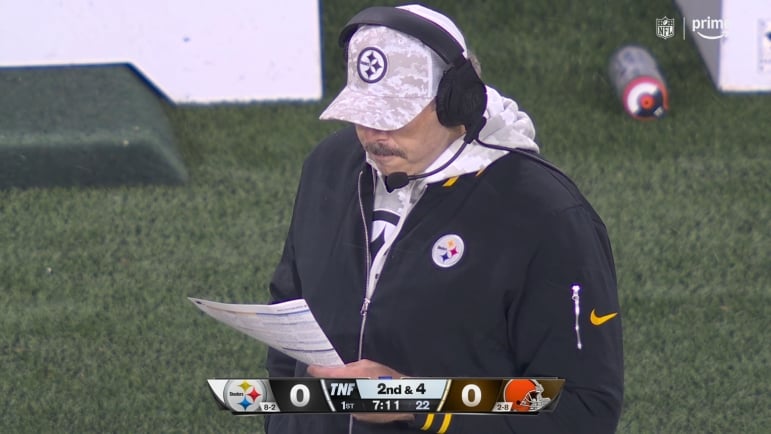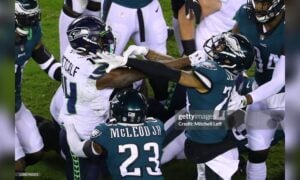Coming away from the Pittsburgh Steelers’ Thursday night loss to the Cleveland Browns, I felt like OC Arthur Smith called a bad game. Partially in the results, netting just 19 points, with a struggling running game and under-siege quarterback in Russell Wilson. But the All-22 always tells a clearer story than the live TV broadcast.
After combing through the tape, I have a mix of takeaways. Below is a breakdown of the scheme and plan, not always the results, and how much Smith is to blame. I’ll break this down by the run- and pass-game concepts.
Steelers’ Run Scheme
Off the top, it’s important to note there may be a division of labor here. This century, the offensive line coach has often been the de facto run-game coordinator even if he didn’t officially hold the title. Mike Munchak, for example, served in that role. The OC was the pass-game coordinator.
But I can’t speak exactly to how things work under current o-line coach Pat Meyer and Smith, especially given that Meyer doesn’t have the gold reputation Munchak did while Smith is a veteran coordinator who I’m sure has lots of control over the offense. Especially since his background is offensive line/tight ends/run game unlike Randy Fichtner, Todd Haley, and Matt Canada, who primarily had pass-game backgrounds.
So I’m going to assume, dangerous as that is, Smith has a big say in the running game. Of the two elements, the Steelers’ run game was far more frustrating to watch than the pass game. I boil it down to a few points.
1 . Too Much Failure, Too Much Repetition
My No. 1 gripe of Smith and the Steelers’ game plan. I understand you can only have so many run-game concepts. They’re not limitless (especially on a short week) but Pittsburgh kept going back to a dry well.
Four times, they used a Pony grouping with RBs Jaylen Warren and Cordarrelle Patterson on the field. All four were runs, three of which were presented the same way. Patterson would orbit around the formation before jogging to the flat on an RPO. The run scheme would be gap. Twice, a short trap with LG Isaac Seumalo pulling to the 3T and a pin/pull scheme with C Zach Frazier out on the move on a run to the right.
The first, to Smith’s credit, was successful. The next three weren’t. Overall, gap schemes overall weren’t working, the Browns’ one-gapping and penetrating defensive line (which even we noted in our pre-game scouting report) was getting upfield and disrupting.
The fourth was a wind-back run to Patterson in the red zone. That run was also unsuccessful, though at least it offered some scheme variation.
Overall, the short trap runs simply were not working in this game. Including the two shown above, Pittsburgh ran it four times on 28 running back carries. Despite their utter lack of success and the Browns adjusting well, in one example, the d-tackle didn’t shoot upfield because he felt RG Mason McCormick climb past him, the Steelers kept banging their head into a wall. Not enough duo or inside zone in this one.
There’s always a tough line between when to stop using plays even if they’re working out of the belief of the defense adjusting but the Steelers started running into a wall. For all four calls to be runs and gap schemes to the same direction made them predictable and the Browns pounced.
Twice, Pittsburgh called “crunch,” a creative double-wham block that on paper I really like. Pittsburgh has been trying it for the last two years. It just hasn’t been successful. Often one block fails and the whole play falls apart. The Steelers tried it twice in this one, including the first snap of the game (out of a diamond look) but they just couldn’t get it blocked up. At some point, you just gotta scrap it. At least for awhile.
2. Bad Backside Plans
Sorta ties in with the above. Pittsburgh made former UDFA linebacker Mohamoud Diabate look like Fred Warner in this game. Their gap schemes offered little realistic plan to block backside linebackers like him.
Here’s what I mean. Pin and pull run to the right. Diabate, No. 43, is left free to chase it from the backside. In theory, the team is asking the backside tackle to climb to him. But because the linebacker is aligned to the inside, the tackle is completely out-leveraged and has zero chance of making this block. And Diabate comes in free to make the play. Same happened later, the Browns stringing Warren out wide and keeping him horizontal down the line. The second clip is one I also used above because it applies here, too.
I think the Steelers tried to clean this up in-game and had the center start taking Diabate. But what they needed was more window dressing to try and slow him down. Wasn’t enough of that to give the tackle time to make the block.
3. Same Plays In Weighty Moments
Exclude the issues of breaking the huddle in time, an issue on fourth down the last two games we’ve already covered.
The two fourth-down calls were counter power from QB Justin Fields and a split zone with Jaylen Warren with the FB running to the flat to “block” and remove one defender from the play (an idea I support).
The issue is that Smith tipped his hand to both of these earlier in the game. Before the Fields 4th-and-2 fail, the team trotted him out for 3rd and 1 on its opening possession. TE Darnell Washington false started on the play and it moved them into 3rd and 6 in which Russell Wilson came back onto the field to run a “normal” passing play.
Though the third-down call was never fully run, the Browns got a sneak peek at it. The ball was snapped and you can begin to see the design. You obviously have the formation and alignment. Then, you see Mason McCormick pulling right to left and you see the first steps from Fields. You can tell he’s sorta taking a jab step and not fully committed to running behind him, even if it’s interrupted by the whistle.
Even if the players didn’t feel it in the moment, I bet the coaching staff did. So when Pittsburgh got into its 4th and 2 the following drive, it did the same thing. Same personnel, same formation, and the same call. Cleveland was not fooled on a play where it has to be fooled for it to work. And that doesn’t even get into the idea of calling this drawn-out play on fourth-and-short.
While I know it looks like Fields should be following McCormick, and I fully understand there was a lane – a big one – this play was designed to go to the right. Fields went the correct way.
It’s sorta like the Ravens game. When Pittsburgh got a preview of Baltimore’s original two-point play before Mike Tomlin called a timeout. The Ravens scrapped it and tried something else, even if that didn’t end up working. Here, Pittsburgh kept its call, and I think Cleveland had a better idea of what it was getting.
I know Smith was trying to work off that power run by McCormick having done so twice against Washington and once against Baltimore. And while the offensive line was the same (Broderick Jones shifted to the left side, Spencer Anderson came in at right tackle), the backfield alignment was different. If you want to make everything look the same to fool the defense, it all has to look the same. The backfield can’t be changed up. Combine that with the preview on the first drive and the Steelers weren’t set up for success.
On the other fourth-down failure, which I would argue is more execution-based than anything I outlined above, it was still a concept the team had run earlier in the game. On 1st and 10 from the Browns’ 46 in the first quarter, they ran the same play out of the same look. Warren gained four yards.
They tried it on 4th and 1 from their 45 in the third quarter. A different down/distance but similar line of scrimmage from the same look. LG Isaac Seumalo lost his block and that was the difference maker, but you have to wonder if the Browns felt like they knew it was coming.
And again, short week, only so many run schemes exist in the world. But you can run same concepts out of different looks and there just wasn’t enough variance in that against the Browns. In a nutshell, that’s my chief complaint. From formation to call, everything looked the same.
Steelers’ Pass Scheme
This is where I offer a modest amount of grace. Partially because the pass game was productive. Russell Wilson went 21-of-28 for 270 yards, and a touchdown without a pick. Generally, those are winning numbers for a run-first offense.
Watching the game live, I felt like the scheme wasn’t creative enough to work guys open. Not enough route combinations. While I still think that’s true to a degree, the All-22 showed what Pittsburgh was trying to solve first: handling the rush.
Facing a Browns pass rush that had been effective this season, having Myles Garrett and a defense with the second-highest pressure rate entering Week 12, that was the main concern. Especially after being sacked four times on Wilson’s first 17 drop backs while under pressure on several others.
Pittsburgh’s plan should be a familiar one. The Steelers had to chip and keep the tight ends and running backs in to protect just in the way opposing teams have to solve for T.J. Watt. Because no pass concept matters if the rush is winning the day.
The consequence to that is they often only had three in the pattern while the other eligibles chipped and released. It makes it harder to come up with great schemes or stressors when you have fewer people to do it with.
It’s a big reason why Wilson was sacked four times. On all four of them, the Browns only rushed their four down linemen. That allowed them to drop seven into coverage. On two of those sacks, Pittsburgh only sent two or three players out into the pattern. When seven gets to cover two or three, players aren’t going to be open. And if you send four true players into the pattern, your protection gets stressed and tackles are on islands.
Still, there’s room for criticism. You can’t just throw up your hands and accept that sort of fate. That was going to be my commentary until charting each of these reps out. Turns out, the Steelers still had success.
Even when sending no more than three players into the pattern (excluding the chip/releasing players who leak out), Wilson did well. He completed 13-of-16 passes for 211 yards and his touchdown to Calvin Austin III. To the intended vertical players, Wilson went 6-of-8 for 183 yards and one touchdown.
Smith used vertical divide routes to help create 1v1 opportunities downfield and hit big plays with the strong-armed Wilson. A 31-yard completion to Pickens, a 35-yarder to Van Jefferson, a 22-yarder to Pat Freiermuth, both of Austin’s big catches of 46 yards and his 23-yard touchdown, came off these concepts.
It also softened things up underneath to the chippers. Overall, it’s hard to argue with the results. These plays worked.
I understand Cleveland’s pass rush and facing Garrett made some of Arthur Smith’s staples difficult to use. It’s harder to run play-action when Garrett is on the field. You’re trying to sell the run, the quarterback is turning his back, the plays take longer, it’s really risky. And Pittsburgh generally didn’t dial up play-action until Garrett was subbed off the field. Smith’s boot game was limited (two, I believe, one to the right where Garrett was triple-teamed and another to the left when he was on the sideline), and play-action was a smaller part of the menu. That hindered the strengths of the Steelers’ plan.
Now, there are things to critique. Smith is not getting a full pass. The quick and short passing game could’ve been better, which would have made chipping less of an issue. There wasn’t enough of that considering the Steelers’ protection issues.
And I didn’t like this third-down call early in the game. Third and 3, Pittsburgh is coming out in 13 personnel (1 RB, 3 TEs) with Ben Skowronek the only receiver to give the illusion of run and keep Cleveland in its base 4-3 defense. The Steelers are running Mesh/Sit. A mesh route with crisscrossing routes underneath to beat man coverage and a sit round behind if the offense gets zone coverage.
Smith’s trying to get too cute here. Present a heavy look and throw out of it. Problem is, they don’t have the athletes to get open. Ben Skowronek and MyCole Pruitt are running the mesh. They’re not going to get open (and the Browns are playing zone though they seem to lock a corner on Skowronek).
There’s nothing here for Wilson. Zero receivers open. A bad sack to take on the edge of field goal range that ends in a missed Chris Boswell 58-yard attempt. If Smith wants to throw here, put some actual receivers out there.
Final Thoughts
As the saying goes, things are never as good or bad as they seem. For Smith, his passing game plan wasn’t as bad as I thought though I really disliked the run-game approach. Don’t mistake this for praise of what Smith did. It still was an underwhelming performance from him. If I had to grade it, we’re talking ‘C’ for the pass game and ‘D-minus’ for the run game (he did have a nice call on Fields’ 30-yard zone-read run).
How Arthur Smith and Pittsburgh adjust for the Cleveland rematch in two weeks should be telling.








